Our Social Security system is best designed for a married couple in which the husband works in the labor market and the wife stays at home. At the time of retirement, the wife is entitled to a monthly benefit equal to 50 percent of her husband's benefit (the spousal benefit). If the husband dies first, a wife is entitled during her retirement years to 100 percent of her husband's benefit (the survivor benefit). This is a generous outcome, considering that the woman in this example never pays a dime in payroll taxes.
Of course, the couple's arrangement could be reversed. That is, the wife could work and the husband could stay at home. Regardless of the arrangement, Social Security is much less generous to two-earner than to one-earner couples. For example, a woman can earn Social Security benefits in her own right. But she cannot claim benefits in her own right in addition to spousal benefits on her husband's contributions. It must be one or the other. Many women who have paid into Social Security over their work lives find that when they reach retirement their best option is to claim benefits on their husband's contributions. As a result, they get nothing in return for all the payroll taxes they paid. Others find that even if it is better to claim benefits on their own contributions, the net benefit is not much more than they would have received if they had never worked and never paid taxes.
Calculating the exact impact of Social Security on working couples is complicated. Going to work, earning a living, and spending one's earnings over time affects a variety of taxes and government benefits – not just in the current year, but in all future years.
If you save and invest some of your current earnings and spend the proceeds in the future, you'll raise your future capital income taxes as well as consumption taxes. You'll also limit your ability to qualify for government tax credits and welfare benefits. Earning more today also will affect your future Social Security benefits and the federal income tax assessed on those benefits.
In order to sort through all of the effects, we consider a hypothetical two-earner couple at various levels of income. The couple has two children and takes advantage of tax avoidance opportunities, including the mortgage interest deduction, the earned-income tax credit, and the child tax credit. When qualified, the couple receives transfer benefits, including Food Stamps and Medicaid.
By incorporating all of the fiscal policies that affect households through time, our model is able to calculate the lifetime consequences of employment. We conclude that because working couples are required to participate in Social Security, they are worse off than they otherwise would be. That is, their lifetime consumption of goods and services is lower than it would be in the absence of Social Security payroll taxes and Social Security benefits. Specifically:
- A couple in which each spouse earns $10,000 a year can expect to pay almost $60,000 in Social Security taxes over and above any benefits they can expect to receive.
- The penalty for participation in Social Security is almost six times the wife's annual wage income.
The penalty for Social Security participation rises with income. A couple in which each earns $80,000 will pay almost twice the lifetime penalty paid by a couple in which each earns $10,000 a year. As a fraction of income, however, the burden of Social Security falls as income rises – reflecting the fact that Social Security tends to be regressive when all lifetime effects are taken into account.
Social Security does not exist in isolation. It is one of a number of government programs that reduce the rewards from working and producing. Consider a one-earner couple in which the husband is in the labor market and the wife is in the home. What does the couple gain, on net, from the wife's decision to enter the labor market? To answer this question, we need to calculate marginal net tax rates. In doing so, we ignore benefits to which people are entitled whether they work or not and only identify changes in taxes paid and benefits received as a result of the decision to work. The additional taxes paid plus the net reduction in transfer benefits received divided by the income from working is called the marginal net tax rate.
These marginal tax rates are quite high:
- If the wife of a male earning $20,000 a year enters the labor market and earns $10,000 a year, her marginal net tax rate will be 122 percent!
- For every dollar she earns, the couple will forgo $1.22 in increased taxes and reduced benefits.
Although it is unusual for marginal net tax rates to exceed 100 percent, it is not unusual for rates to exceed 50 percent. Indeed, second-earner spouses in moderate-income families typically lose more that half of all they earn to higher taxes and lower transfer benefits.
The mere act of marrying another wage earner can create strong disincentives to work. For example:
- A woman earning the minimum wage faces a marginal net tax rate of 21 percent if her husband does not work; if he also earns the minimum wage, her marginal tax rate will be 96 percent.
- At roughly twice the minimum wage ($20,000), her tax rate is 56 percent as long as her husband does not work; if he works and earns $10,000 a year, her marginal tax rate will be 106 percent.
Why are the marginal net tax rates faced by second-earner spouses so high? They are high at the low end of the income ladder because of the loss of means-tested benefits. Our system is very generous to those who do not work but withdraws those benefits quickly as people work and produce. For example:
- If a husband and wife both earn $10,000 a year, the wife's marginal tax rate will be 96 percent.
- About 65 percent of this marginal tax rate consists of the loss of Medicaid and other welfare benefits as a result of the wife's decision to work.
If the husband earns a higher income, the marginal tax rate is significantly lower (but still quite high) and the components of the tax rate change:
- If the husband earns $30,000 and the wife earns $10,000, her marginal tax rate will be 48 percent.
- Less than one-fourth of this marginal tax rate consists of loss of benefits, while more than three-fourths consists of taxes – mainly income and payroll taxes.
What is the contribution of Social Security to these marginal net tax rates? Consider that:
- If both spouses earn $10,000, 27 percentage points of the wife's marginal tax rate is due to Social Security alone.
- This means she loses more than one out of every four dollars she earns because of the existence of Social Security.
- At a wage of $20,000 a year, she loses more than one out of every seven dollars.
In general, Social Security penalizes moderate-income families by claiming one of every six or seven dollars the second-earner spouse receives. Thus virtually all of the Social Security payroll tax is a loss for the working spouse.
[page]Working couples in the United States face extremely high tax rates. Part of the reason is that some taxing mechanisms were designed years ago on the model of the one-earner household. Thus when a working man marries a stay-at-home woman, their combined income tax burden typically falls (the marriage bonus). Conversely, when two wage earners marry – as is often the case today – their income tax burden typically rises (the marriage penalty).
"Social Security was designed for a one-earner couple."
Like the income tax system, the Social Security system is best designed for a married couple in which the husband works in the labor market and the wife stays at home. At the time of retirement, the wife is entitled to a monthly benefit equal to 50 percent of her husband's benefit (the spousal benefit). If the husband dies first, a wife is entitled during her retirement years to 100 percent of her husband's benefit (the survivor benefit). This is a generous outcome, considering that the woman in this example never pays a dime in payroll taxes.
Of course, the couple's arrangement could be reversed. That is, the wife could work and the husband could stay at home. Although less than 2 percent of retirees now claiming a spousal benefit are men,1 that number is likely to grow. In any case, women, on the average, have a much greater stake in what happens during the retirement years because they live longer. Life expectancy at birth for a female is 5.7 years longer than for a male.2
In general, Social Security is much less generous to women who earn wages and pay taxes than it is to married women who remain outside the labor market. A woman can earn Social Security benefits in her own right. But she cannot claim benefits in her own right in addition to claiming spousal benefits on her husband's contributions. It must be one or the other.
"Many Women get nothing in return for their payroll taxes claiming a spousal benefit instead."
Many women who have paid into Social Security over their work lives find that when they reach retirement their best option is to claim benefits on their husband's contributions.3 As a result, they get nothing in return for all the payroll taxes they paid. Others find that even if it is better to claim benefits on their own contributions, the net benefit is not much more than they would have received if they had never worked and never paid taxes.
[page]4In an earlier study, Kotlikoff found that virtually all young workers are worse off as a result of their forced participation in Social Security. That is, at virtually every income level, young workers can expect to pay more in Social Security taxes than they will get back in Social Security benefits. For example:5
- Young workers earning the average income can expect to pay $723,591 in taxes over the course of their lifetimes (in present value terms) and receive only $140,190 in benefits.
- For higher-income workers the picture is much worse: expected taxes are $1,274,136, while expected benefits are only $163,861.
This study builds on the earlier study by focusing on two-earner couples in which each spouse is entitled to benefits as a result of the other's contributions and by taking into account all other tax and transfer programs that are affected by Social Security. For example, absent the Social Security payroll tax, wage income would be higher – leading to higher income taxes and, in some cases, fewer welfare benefits. Social Security income during retirement will typically trigger additional income taxes (at least for people who are young today) and make qualifying for means-tested benefits more difficult. Our goal in this study is to sort through all of these effects.
"Going to work raises taxes and reduces government benefits."
Taxes and Government Benefits Affected by the Decision to Work.The decision to enter the labor market and earn a wage has a number of economic consequences. In general, more work means a higher income and, therefore, higher taxes. A higher income usually also leads to fewer welfare benefits (such as Food Stamps). Moreover, the effects of working today are not limited to today's higher taxes and today's loss of entitlement benefits. Income earned today also affects future taxes and future benefits. In particular, there are five important links between today's decisions and their future consequences:
- Earning more today typically leads to more saving and, therefore, more assets and more income from assets in the future; however, that higher future capital income will result in higher future income taxes.
- More assets and more income in the future also will mean fewer future benefits from entitlement programs that are linked to the income and assets of the recipients (such as Medicaid).
- Earning more today typically will lead to more consumption in the future because asset accumulation makes more consumption possible; however, that higher consumption will result in higher consumption taxes.
- Earning more today will lead to higher Social Security benefits in the future.
- More non-Social Security income in the future, caused by higher earnings and more saving today, will increase the tax on future Social Security benefits.
Calculating the Costs and Benefits of Working. As the above list indicates, understanding the full consequences of deciding to work requires taking into account all future taxes workers will pay plus all future transfer payments workers will lose as a result of that decision. To illustrate this lifetime analysis, we have chosen a representative two-earner couple. The couple is assumed to rent in the early years and eventually buy a house. They have two children, who grow up and attend college. Over time, the couple has many opportunities to interact with the tax system by, for example, taking advantage of the mortgage interest deduction and the child tax credit, deciding whether to itemize deductions, paying payroll (FICA or Federal Insurance Contributions Act) taxes, paying state income taxes, and using their after-tax earnings to pay sales taxes.
"Various welfare benefits, tax deductions and tax credits are phased out as income rises."
We assume that couples enter the labor market at a specific wage and that their income grows by 1 percent per year in real terms, and we consider this couple at different income levels. For example, if they earn a low income they benefit from the Earned Income Tax Credit (EITC) and the credit for retirement account contributions. If they earn a high income, they are penalized by the phase-out of itemized deductions and by the alternative minimum tax. We approach entitlement benefits in a similar way. If they earn a low income, the family qualifies for "welfare" benefits including cash assistance, Food Stamps and Medicaid. As their level of income or assets rises, these benefits phase out.
Our approach is also probabilistic. In any given year, there is some chance one or both spouses will die. The death of a spouse triggers entitlement benefits for the remaining spouse and the children (such as survivor benefits under Social Security). These benefits are also affected by what the deceased spouse was earning. We calculate expected taxes and expected benefits for the couple. We do so by calculating the taxes and benefits for each possible lifetime. To get an expected result, we sum over all possible lifetimes, each weighted by its probability of occurring.
Our approach is also comprehensive. We include every major tax and transfer program. In the case of taxes, we include employer-paid taxes, whether corporate income taxes or employer-paid FICA taxes.
The Complexity of U.S. Tax and Transfer Benefit Programs. It is difficult to exaggerate the complexity of the tax and transfer programs American workers face. Mastering the federal income tax alone is a major challenge because it has so many special provisions. These include the inflation-indexation of tax brackets, the partial and graduated taxation of Social Security benefits above two noninflation-indexed thresholds, the treatment of retirement account contributions and withdrawals, the phase-out of itemized deductions, the EITC, the child tax credit, the alternative minimum tax, and the recently legislated credit to low-income households for contributing to retirement accounts.
As if the federal income tax were not difficult enough to decipher, almost all states have income taxes with their own special provisions. For example, Massachusetts has an exemption for the elderly, a child deduction, a rental deduction, and a deduction for employee-paid payroll taxes. An explanation of the major tax programs is provided in our previous NCPA study.6
As the various interrelated social welfare programs have grown, the U.S. system of transfer benefits has become extremely complicated. It now includes Food Stamps, Medicaid, traditional welfare (renamed TANF or Temporary Assistance for Needy Families), Supplemental Security Income (SSI), housing assistance programs, the Low-Income Home Energy Assistance Program (LIHEAP), the Special Supplemental Nutrition Program for Women, Infants and Children (WIC), and several other programs. An explanation of the major entitlement programs is included in our previous NCPA study.7
"The decision to work has lifetime effects on taxes and benefits."
Software Program. Understanding the effective net tax on work requires an intertemporal model capable of carefully determining tax and transfer payments at each stage of a person's life cycle, based in part on economic choices in prior periods. This study uses ESPlanner, a financial planning software program developed by Economic Security Planning, to study the net tax levied on workers with different earning capacities. ESPlanner smooths households' living standards subject to constraints on their capacities to borrow. In so doing, it makes highly detailed, year-by-year federal and state income tax and Social Security benefit calculations.8
[page]9In order to assess the consequences of going to work, we need to calculate over a lifetime the extra taxes paid and extra benefits received or sacrificed as a result of that decision. In what follows, all lifetime taxes and transfer benefits are reported as present values.
Lifetime Taxes. Consider couples in which both spouses earn the same wage. Ignoring the lowest income levels, consider that:
- A couple earning an annual income of $42,800 can expect to pay more than $300,000 in taxes over the course of their lifetimes – an amount equal to about seven times their initial annual income.10
- A couple earning about $100,000 can expect to pay close to a million dollars in lifetime taxes – an amount equal to almost 10 times their initial annual earnings.
- At higher levels of income, expected lifetime taxes tend to be between 10 and 11 times initial annual earnings, regardless of the amount earned.
On the tax side, then, our system is mildly progressive. As a percent of lifetime income, the tax burden rises modestly as income rises, then levels off once income rises above $100,000.
The Composition of Lifetime Taxes. One reason why the overall tax system is not more progressive is that people pay different types of taxes at different income levels. Although the rate structure of the federal income tax system is fairly progressive, payroll taxes tend to be proportional to income (although typically capped at a certain income level) and consumption taxes tend to be regressive, taking a larger portion of lower family incomes. In general, the tax burden borne by lower-income families tends to be weighted toward proportional and regressive taxes:11
- For a family earning $32,100 a year, half the taxes paid are payroll taxes and only 30 percent are income taxes.
- By contrast, for a family earning 10 times as much, three-fourths of all taxes are paid in the form of income taxes, and less than one in five tax dollars comprises payroll taxes.
"A minimum wage couple can expect to pay $100,000 in taxes and receive $270,000 in entitlement benefits over their lifetimes."
Lifetime Transfer Benefits. A couple in which both spouses initially earn the minimum wage and remain at the bottom of the income ladder throughout their working lives can expect to pay more than $100,000 in taxes over their lifetimes. However, they can expect to receive back almost $270,000 in benefits. Thus a low-income household gets a very good return on its taxes. (Note, however, that it is very difficult to work full time and earn only the minimum wage for four to five decades.) Going beyond the lowest income level, consider that:
- A couple earning an annual income of $42,800 can expect to receive about $94,000 in lifetime entitlement benefits, measured in current dollars.
- At $85,700, the couple's expected entitlement benefits rise to $104,000.
- At an income level of about $170,000, the couple's entitlement benefits reach about $127,000, where they remain, regardless of the size of the family's income.
Unlike taxes, which tend to be proportional to income once a certain income level is reached, transfer benefits tend to be constant once a certain income level is reached. This means that benefits as a percent of income tend to fall as income rises.
- At $42,800, couples can expect to get back about $1 in transfer benefits for every $3 they pay in taxes.
- At $85,700, couples can expect to get back less than one in seven dollars they pay in taxes.
- At about $200,000 in income, they can expect to get back less than one in 16 tax dollars.
Composition of Transfer Benefits. The principal reason why transfer programs tend to be more progressive than the tax system is that many programs are means-tested. Although rich and poor alike participate in Medicare and Social Security, only low-income families have access to means-tested benefits, the most important of which is Medicaid. Moreover:
- About 70 percent of all transfer benefits received by a couple earning the minimum wage over the course of their working lives consists of Medicaid benefits, and only one in four dollars is in the form of Social Security and Medicare benefits.
- By contrast, a couple earning $150,000 receives all of its transfer benefits in the form of Social Security (73 percent) and Medicare (27 percent).
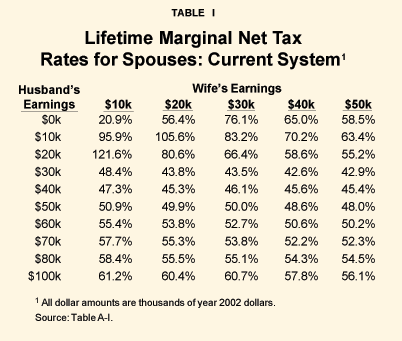
"The marginal net tax rate reflects the penalties for working over the course of a lifetime."
Consider a one-earner couple in which the husband is in the labor market and the wife is in the home. What does the couple gain, on net, from the wife's decision to enter the labor market? To answer this question, we need to calculate marginal net tax rates. In doing so, we ignore benefits to which people are entitled whether they work or not. We want to identify changes in taxes paid and benefits received as a result of the decision to work. The additional taxes paid plus the net reduction in transfer benefits received divided by the income from working is the marginal net tax rate.
"Second-earner spouses face extremely high marginal tax rates."
A selection of these rates is shown in Table I. A more complete array is depicted in Table A-I in the appendix. The first thing to note about Table I is that the marginal tax rates faced by second-earner spouses are extremely high:
- Consider a male earning $20,000 a year.
- If his wife enters the labor market and earns $10,000 a year, her marginal net tax rate is 122 percent.
- For every dollar she earns, the couple will forgo $1.22 in increased taxes and reduced benefits.
"Marginal net tax rates tend to be higher for lower-income couples."
Although it is unusual for marginal net tax rates to exceed 100 percent, it is not unusual for rates to exceed 50 percent. Indeed, second-earner spouses in moderate-income families typically lose more that half of all they earn to higher taxes and lost transfer benefits.
The second thing to notice about Table I is that marginal net tax rates are typically higher for couples with lower incomes. For example:
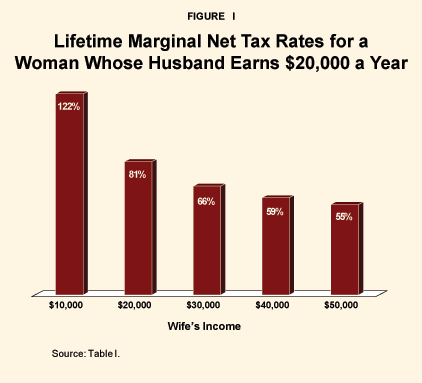
- If a husband and wife both earn $20,000, the wife faces an 81 percent marginal net tax rate; the rate drops to 55 percent if her earnings rise to $50,000. [See Figure I.]
- The wife of a man who earns $50,000 faces a 51 percent marginal net tax rate if she earns $10,000, but a 48 percent tax rate if she earns $50,000.
- The wife of a man who earns $100,000 faces a 61 percent tax rate if she earns $10,000, but only 56 percent if she earns $50,000.
"At most income levels, marrying another worker creates a strong disincentive to work."
Why do marginal tax rates decline as the spouse earns more income? This is the opposite of what one might expect. The answer, as we shall see, is that as her earnings rise the family loses many means-tested benefits. The system is progressive in the sense that it provides substantial benefits – even to those who do not work at all. But it withdraws those benefits rapidly as income rises. Thus the price of a generous welfare state is a structure of very high marginal tax rates that impose large penalties on those who work and produce.
The third thing to note about Table I is that the mere act of marrying another wage earner can create strong disincentives to work. As Figure II shows:
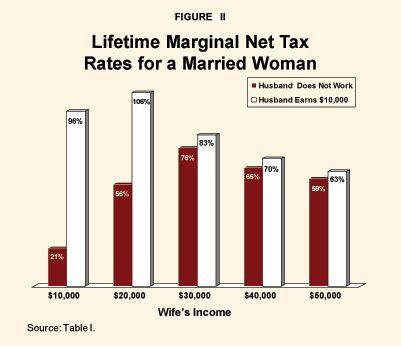
- A woman earning the minimum wage faces a marginal net tax rate of 21 percent if her husband does not work; if he also earns a minimum wage, her marginal tax rate is 96 percent.
- At roughly twice the minimum wage ($20,000), her tax rate is 56 percent as long as her husband does not work; if he works and earns $10,000 a year, her marginal tax rate is 106 percent.
Figure III shows that being married to a high-income husband also can produce very high marginal tax rates, even if the wife's income is very low. For example:
- A woman whose husband earns $100,000 a year faces a 61 percent tax rate – even if her earnings are close to the minimum wage.
- This woman will have to forgo more than half of all she earns in taxes and lost benefits no matter how little she earns.
Figure IV shows that only in the middle-income range does being married to a wage-earning spouse lower net marginal tax rates;
- A woman who earns $30,000 faces a 76 percent marginal tax rate so long as her husband does not work; if he also earns $30,000, her marginal tax rate falls to 44 percent.
- If she earns $40,000, the differential tax rates are 65 percent (nonworking husband) versus 43 percent (working husband).
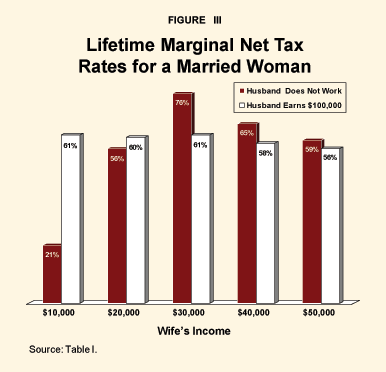
These figures are consistent with an observation made about the tax system by McCaffery: The system encourages women in high-income families not to work and women in low-income families not to marry.12
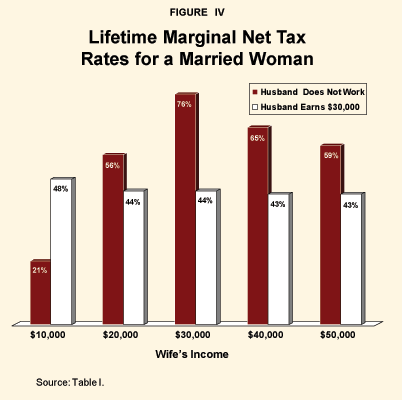
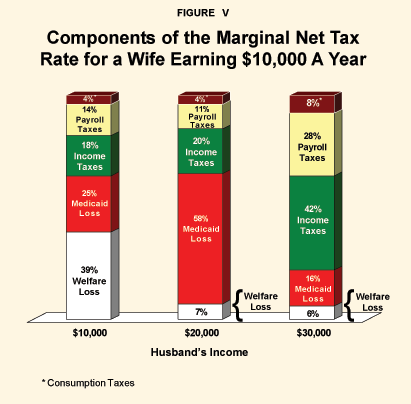
Why are marginal net tax rates so high for working spouses in two-earner families? As noted above, marginal tax rates are high at the low end of the income ladder because of the loss of means-tested benefits. Our system is very generous to those who do not work, but it withdraws those benefits quickly as people work and produce.
The components of marginal net tax rates for a woman who earns $10,000 a year are depicted in Figure V:
- If the husband also earns $10,000 a year, the wife's marginal tax rate is 96 percent. [See Table I.]
- About 65 percent of this marginal tax rate consists of the loss of Medicaid and other welfare benefits as a result of the wife's decision to work. [See Figure V.]
If the husband earns a higher income, the marginal tax rate is significantly lower (but still quite high) and the components of the tax rate change:
- If the husband earns $30,000 and the wife earns $10,000, her marginal tax rate is 48 percent. [See Table I.]
- Less than one-fourth of this marginal tax rate consists of loss of benefits, while more than three-fourths consists of taxes – mainly income and payroll taxes. [See Figure V.]
"Only middle-income workers face a lower net tax after marriage."
Figure VI shows the composition of the marginal net tax rate for a woman who earns $30,000 a year:
-
If her husband earns $10,000, her marginal net tax rate is 83 percent.
-
In this case, more than half of the penalty for working consists of loss of entitlement benefits and the remainder is lost to taxes.
-
If her husband also earns $30,000, her marginal net tax rate drops to 44 percent.
-
In this case, only 13 percent of the penalty for working consists of loss of benefits; 77 percent of the loss is due to taxes.
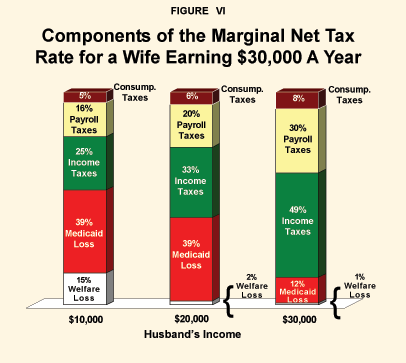
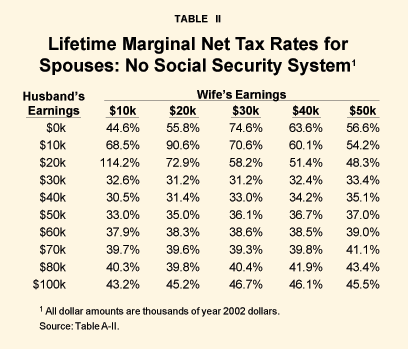
"If the couple earns $60,000, almost 80 percent of the wife's penalty for working is due to direct taxes."
What would marginal net tax rates look like absent the Social Security system? To answer that question, we remove Social Security benefits as well as payroll taxes that support those benefits and the Social Security benefits tax in our model. Some of the results are depicted in Table II.
A quick comparison of Tables I and II suggests that Social Security makes a big difference. Many marginal net tax rates that approach one-half of lifetime income in Table I approach one-third of income in Table II. [See Figure VII.] Table III, a more precise illustration, shows how much Social Security adds to the marginal net tax rates of working spouses.
"Only couples below the poverty level are net gainers from Social Security."
The first thing to note about Table III is that all the entries except one are positive. The first row depicts a working wife with a nonworking husband. Hence, when she is earning $10,000, the family income is $10,000. Only at this poverty-level income does the couple actually gain from participation in Social Security. For every other income combination, the entries are positive (Social Security adds to marginal net tax rates) and usually substantially so. Consider Figure VIII, for example:

- If both spouses earn $10,000, 27 percentage points of the wife's marginal tax rate is due to Social Security alone.
- This means she loses more than one out of every four dollars she earns because of the existence of Social Security.
- At a wage of $20,000 a year, she loses more than one out of every seven dollars.
The second thing to notice is that for moderate-income families the penalty for participating in Social Security is quite high – one of every six or seven dollars the second-earner spouse receives. Thus virtually all of the Social Security payroll tax is a loss for the working spouse.
The third thing to notice about Table III is that the smallest entries are along the top row. This reflects the fact that the system highly favors one-earner couples:
- Consider a husband who moves from no work (row one) to a $10,000 job (row two).
- If the wife earns $20,000, the penalty for participating in Social Security jumps from 0.6 percent to 15 percent.
- At $30,000, her husband's work effort increases her marginal tax rate from 1.5 percent to 12.6 percent; at $40,000, it goes up from 1.4 percent to 10.1 percent.
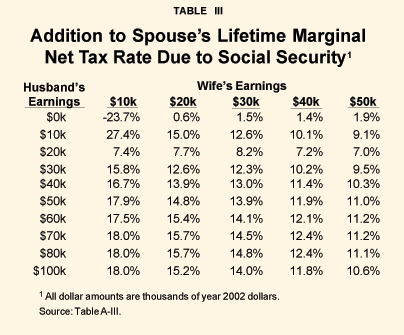
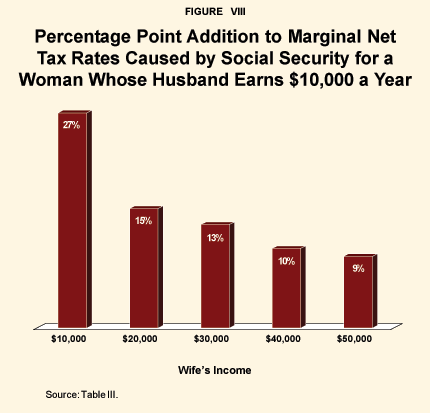
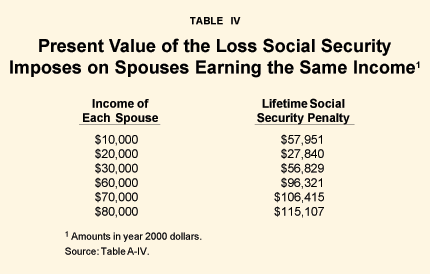
Because working couples are required to participate in Social Security, they are worse off than they otherwise would be. That is, their lifetime consumption of goods and services is lower than it would be in the absence of Social Security payroll taxes and Social Security benefits.
How much worse off are young couples? Table IV illustrates the lifetime penalty in today's dollars of forced participation in Social Security. As the table shows:
- A couple in which each spouse earns $10,000 a year can expect to pay almost $60,000 in Social Security taxes over and above any benefits during their lifetimes.
- The penalty for participating in Social Security is almost six times the wife's annual wage income.
"The penalty from Social Security falls as income rises."
Note that the penalty for Social Security participation rises with income. So a couple in which each earns $80,000 will pay almost twice the lifetime penalty paid by a couple in which each earns $10,000 a year. As a fraction of income, however, the burden of Social Security falls as income rises – reflecting the fact that the burden of Social Security tends to be regressive when all lifetime effects are taken into account.
This is illustrated in Figure IX, which shows the case of a couple in which the husband earns $50,000 a year. Note that:
- When the wife earns $10,000 a year, the lifetime burden of Social Security is equal to more than three times her annual income.
- At $100,000 a year, however, the lifetime burden of Social Security is roughly equal to her annual income.
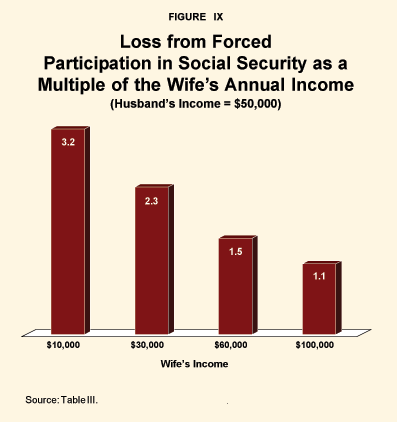
Social Security was created in an era in which the typical household consisted of a working husband and a stay-at-home wife. The structure of Social Security rewards that type of arrangement and penalizes two-earner households.
"All young people will pay more in Social Security taxes than they will receive in benefits, with the greatest burden on two-earner couples."
Although all young people can expect to pay more in taxes than they receive in benefits, Social Security is especially burdensome for someone whose spouse is also in the labor market. The lifetime penalties Social Security imposes on two-earner couples are high both in absolute terms and as a percent of income.
Surprisingly, the penalties relative to income are highest for those at the bottom of the income ladder.
NOTE: Nothing written here should be construed as necessarily reflecting the views of the National Center for Policy Analysis or as an attempt to aid or hinder the passage of any bill before Congress.
[page]- See Rudolph Penner, "Social Security and Women," in Celeste Colgan, ed., Women's Agenda (Dallas, Texas: National Center for Policy Analysis, 2002).
-
"The 2001 Annual Report of the Boards of Trustees of the Federal Old-Age and Survivors Insurance and Disability Insurance Trust Funds," Table V, A3.
-
In 2001, 34 percent of women aged 62 or older received a benefit based solely on their husband's earnings record in 2001. If they paid payroll taxes during their working years, they did not work enough to qualify for a Social Security benefits. An additional 28 percent of women qualified for a Social Security benefit in their own right, but instead chose to take a benefit based on their husband's earnings, presumably because the benefit was larger. Thus, up to 62 percent of female beneficiaries got no extra benefit in return for the taxes they paid. Social Security Administration, "Fast Facts and Figures About Social Security," 2002, page 22.
-
This section is based largely on Jagadeesh Gokhale, Laurence Kotlikoff and Alexi Sluchynsky, "Does It Pay to Work?" NCPA Policy Report No. 258, March 2003, National Center for Policy Analysis.
-
Laurence Kotlikoff, "Privatizing Social Security," NCPA Policy Report No. 217, July 1998, National Center for Policy Analysis, Figure IV, p. 2.
-
Gokhale et al., "Does It Pay to Work?"
-
Gokhale et al., "Does It Pay to Work?"
-
A full explanation can be found in the appendix to Gokhale et. al., "Does It Pay to Work?"
-
The results in this section are from Gokhale et al., "Does It Pay to Work?"
-
A full-time worker earning the minimum wage of $5.15 an hour will earn $10,700 a year. When both spouses earn the minimum wage, their family income will be $21,400. If both spouses earn twice the minimum wage ($10.30 an hour), their joint annual income will be $42,800.
-
An income of $32,100 is 1.5 times the minimum wage. An income 10 times as high, or about $321,000, is 15 times the minimum wage.
-
Edward J. McCaffery, "Women and Taxes," National Center for Policy Analysis, NCPA Policy Report No. 250, February 2002, National Center for Policy Analysis.
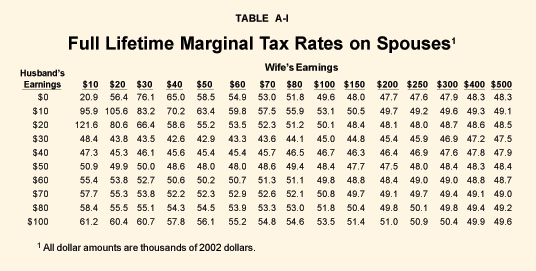
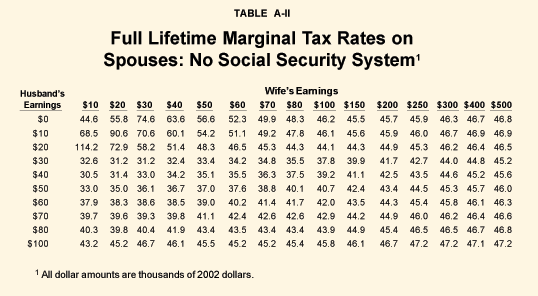
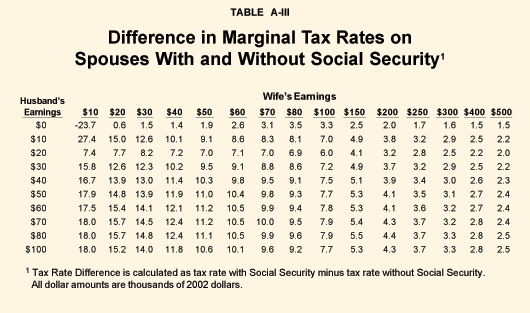
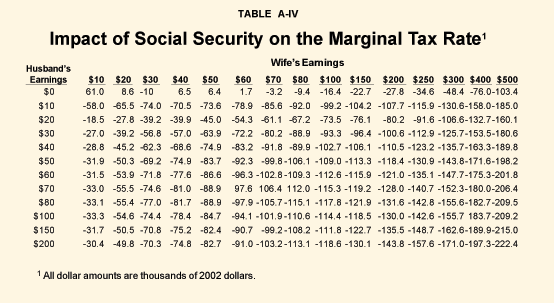
Jagadeesh Gokhale is a senior economic adviser with the Federal Reserve Bank of Cleveland and works in the areas of public finance, macroeconomics and applied microeconomics. He received his doctorate in economics from Boston University. He has published papers on national saving, private pensions, wealth inequality, and generational accounting in top academic journals and books. Dr. Gokhale has coauthored several chapters on U.S. fiscal policy in the Budget of the United States Government and has testified before the Senate Budget Committee on U.S. Social Security reform. In his work on labor markets, he has analyzed the relationship between worker productivity and compensation and the impact of firms' wage and employment structures on corporate ownership patterns. Dr. Gokhale has published articles in the Quarterly Journal of Economics, the Journal of Economic Perspectives, the Review of Economics and Statistics and a number of publications of the National Bureau of Economic Research.
Laurence J. Kotlikoff is Professor of Economics at Boston University, Research Associate of the National Bureau of Economic Research, Fellow of the Econometric Society, a member of the Executive Committee of the American Economic Association and President of Economic Security Planning, Inc., a company specializing in financial planning software. Professor Kotlikoff received his B.A. in Economics from the University of Pennsylvania in 1973 and his Ph.D. in Economics from Harvard University in 1977. From 1977 through 1983 he served on the faculties of economics of the University of California, Los Angeles and Yale University. In 1981-82 Professor Kotlikoff was a Senior Economist with the President's Council of Economic Advisers. Professor Kotlikoff has served as a consultant to the International Monetary Fund, the World Bank, the Harvard Institute for International Development, the Organization for Economic Cooperation and Development, the Swedish Ministry of Finance, the Norwegian Ministry of Finance, the Bank of Italy, the Bank of Japan, the Government of Russia, the Government of Bolivia, the Government of Bulgaria, the Treasury of New Zealand, the Office of Management and Budget, the U.S. Department of Education, the U.S. Department of Labor, the Joint Committee on Taxation, the Commonwealth of Massachusetts, the American Council of Life Insurance, and Merrill Lynch, Fidelity Investments and other major U.S. corporations. He has provided expert testimony on numerous occasions to committees of Congress. Professor Kotlikoff is coauthor (with Alan Auerbach) of Macroeconomics: An Integrated Approach and Dynamic Fiscal Policy; author of Generational Accounting, What Determines Savings?; coauthor (with Daniel Smith) of Pensions in the American Economy; and coauthor (with David Wise) of The Wage Carrot and the Pension Stick. In addition, he has published extensively in professional journals, newspapers and magazines.